
Illustrative Math Alignment: Grade 8 Unit 6
Associations in Data
Lesson 11: Gone In 30 Seconds
Use the following Media4Math resources with this Illustrative Math lesson.
| Thumbnail Image | Title | Body | Curriculum Topic |
|---|---|---|---|
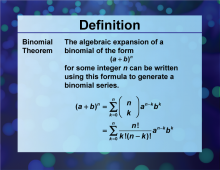
|
Definition--Sequences and Series Concepts--Binomial Theorem | Binomial TheoremTopicSequences and Series DefinitionThe binomial theorem describes the algebraic expansion of powers of a binomial. DescriptionThe binomial theorem is a fundamental theorem in algebra that provides a formula for expanding binomials raised to any positive integer power. This theorem is essential in various mathematical disciplines, including algebra, calculus, and probability theory. |
Series |
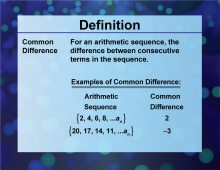
|
Definition--Sequences and Series Concepts--Common Difference | Common DifferenceTopicSequences and Series DefinitionThe common difference is the difference between consecutive terms in an arithmetic sequence. DescriptionThe common difference is a key concept in arithmetic sequences, representing the consistent interval between consecutive terms. This concept is fundamental in understanding linear patterns and is widely used in various mathematical applications. |
Sequences |
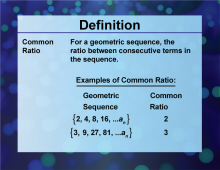
|
Definition--Sequences and Series Concepts--Common Ratio | Common RatioTopicSequences and Series DefinitionThe common ratio is the ratio between consecutive terms in a geometric sequence. DescriptionThe common ratio is a fundamental concept in geometric sequences, representing the consistent factor by which each term is multiplied to obtain the next term. This concept is crucial in understanding exponential growth and decay, which are prevalent in various mathematical and scientific applications. |
Sequences |
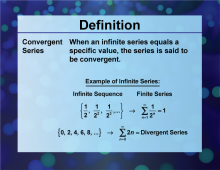
|
Definition--Sequences and Series Concepts--Convergent Series | Convergent SeriesTopicSequences and Series DefinitionA convergent series is a series whose terms approach a specific value as the number of terms increases. DescriptionA convergent series is a critical concept in the study of sequences and series, where the sum of its terms approaches a finite limit as the number of terms increases. This concept is essential in various mathematical and scientific applications, including calculus and analysis. |
Series |

|
Definition--Sequences and Series Concepts--Divergent Series | Divergent SeriesTopicSequences and Series DefinitionA divergent series is a series whose terms do not approach a specific value as the number of terms increases. DescriptionA divergent series is a significant concept in the study of sequences and series, where the sum of its terms does not approach a finite limit as the number of terms increases. This concept is essential in various mathematical and scientific applications, including calculus and analysis. |
Series |
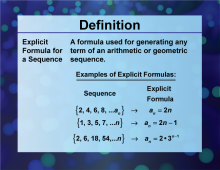
|
Definition--Sequences and Series Concepts--Explicit Formula for a Sequence | Explicit Formula for a SequenceTopicSequences and Series DefinitionAn explicit formula for a sequence provides a direct way to calculate any term in the sequence. DescriptionAn explicit formula for a sequence is a mathematical expression that allows for the direct computation of any term in the sequence without needing to know the previous terms. This concept is fundamental in the study of sequences and series and is widely used in various mathematical applications. |
Sequences |
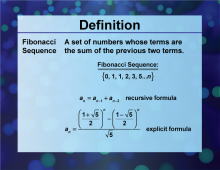
|
Definition--Sequences and Series Concepts--Fibonacci Sequence | Fibonacci SequenceTopicSequences and Series DefinitionThe Fibonacci sequence is a sequence where each term is the sum of the two preceding ones, starting from 0 and 1. DescriptionThe Fibonacci sequence is a famous sequence in mathematics, where each term is the sum of the two preceding ones, starting from 0 and 1. This sequence is significant in various mathematical and scientific applications, including computer science, biology, and art. |
Sequences |
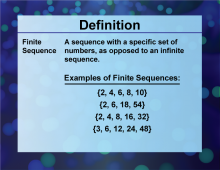
|
Definition--Sequences and Series Concepts--Finite Sequence | Finite SequenceTopicSequences and Series DefinitionA finite sequence is a sequence that has a limited number of terms. DescriptionA finite sequence is a sequence with a specific number of terms, making it a crucial concept in the study of sequences and series. This concept is fundamental in various mathematical applications where the number of elements is limited, such as in statistics and computer science. In real-world applications, finite sequences are used in data analysis, where datasets have a specific number of entries. They are also used in computer algorithms that process a fixed number of elements. Algebraically, a finite sequence can be represented as |
Sequences |
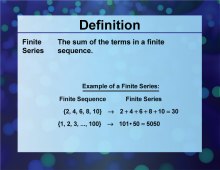
|
Definition--Sequences and Series Concepts--Finite Series | Finite SeriesTopicSequences and Series DefinitionA finite series is the sum of the terms of a finite sequence. DescriptionA finite series is a significant concept in mathematics, representing the sum of the terms of a finite sequence. This concept is essential in various mathematical and scientific applications, including statistics, finance, and computer science. In real-world applications, finite series are used in financial calculations, such as determining the total amount of payments over a fixed period. They are also used in data analysis to find the sum of a dataset. Algebraically, a finite series can be expressed as |
Series |
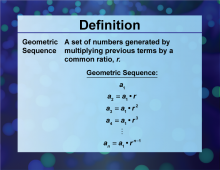
|
Definition--Sequences and Series Concepts--Geometric Sequence | Geometric SequenceTopicSequences and Series DefinitionA geometric sequence is a sequence of numbers where each term after the first is found by multiplying the previous term by a fixed, non-zero number called the common ratio. DescriptionA geometric sequence is a fundamental concept in mathematics, particularly in the study of sequences and series. It is defined by the property that each term after the first is the product of the previous term and a constant, known as the common ratio. This concept is crucial in various mathematical applications, including exponential growth and decay. |
Sequences |
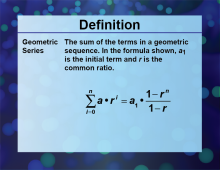
|
Definition--Sequences and Series Concepts--Geometric Series | Geometric SeriesTopicSequences and Series DefinitionA geometric series is the sum of the terms of a geometric sequence. DescriptionA geometric series is a significant concept in mathematics, especially in the study of sequences and series. It is formed by adding the terms of a geometric sequence. This concept is crucial for understanding how sums of exponential patterns are calculated, which has applications in various fields such as finance, engineering, and computer science. |
Series |
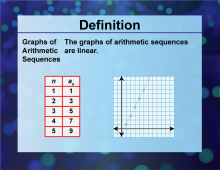
|
Definition--Sequences and Series Concepts--Graphs of Arithmetic Sequences | Graphs of Arithmetic SequencesTopicSequences and Series DefinitionGraphs of arithmetic sequences form a linear graph on a coordinate plane. DescriptionGraphs of arithmetic sequences are a visual tool used in mathematics to represent the terms of an arithmetic sequence on a coordinate plane. This concept is crucial for understanding linear patterns and relationships in sequences and series. |
Sequences |
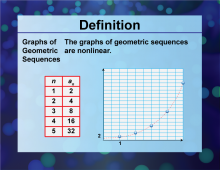
|
Definition--Sequences and Series Concepts--Graphs of Geometric Sequences | Graphs of Geometric SequencesTopicSequences and Series DefinitionGraphs of geometric sequences visually represent the terms of a geometric sequence on a coordinate plane. These are nonlinear graphs. DescriptionGraphs of geometric sequences are a visual tool used in mathematics to represent the terms of a geometric sequence on a coordinate plane. This concept is crucial for understanding exponential patterns and relationships in sequences and series. |
Sequences |

|
Definition--Sequences and Series Concepts--Infinite Sequence | Infinite SequenceTopicSequences and Series DefinitionAn infinite sequence is a sequence that continues indefinitely without terminating. DescriptionAn infinite sequence is a fundamental concept in mathematics, representing a sequence that continues indefinitely without terminating. This concept is essential in various mathematical and scientific applications, including calculus and analysis. In real-world applications, infinite sequences are used in mathematical modeling and simulations where processes continue indefinitely, such as in population dynamics or financial forecasting. Algebraically, an infinite sequence can be represented as |
Sequences |
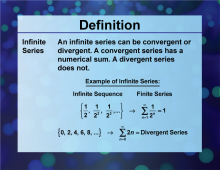
|
Definition--Sequences and Series Concepts--Infinite Series | Infinite SeriesTopicSequences and Series DefinitionAn infinite series is the sum of the terms of an infinite sequence. DescriptionAn infinite series is a significant concept in mathematics, representing the sum of the terms of an infinite sequence. This concept is essential in various mathematical and scientific applications, including calculus and analysis. In real-world applications, infinite series are used in mathematical modeling and simulations where processes continue indefinitely, such as in signal processing or financial forecasting. Algebraically, an infinite series can be represented as |
Series |
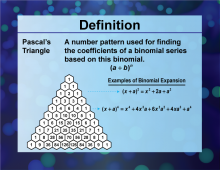
|
Definition--Sequences and Series Concepts--Pascal's Triangle | Pascal's TriangleTopicSequences and Series DefinitionPascal's Triangle is a triangular array of binomial coefficients. DescriptionPascal's Triangle is a fundamental concept in mathematics, representing a triangular array of binomial coefficients. This concept is essential in various mathematical and scientific applications, including combinatorics, algebra, and probability theory. In real-world applications, Pascal's Triangle is used in probability calculations, particularly in binomial expansions and combinatorial problems. It is also used in computer science for algorithm design. Algebraically, the elements of Pascal's Triangle can be expressed as |
Series |
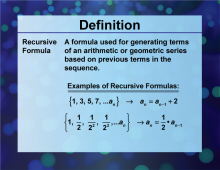
|
Definition--Sequences and Series Concepts--Recursive Formula | Recursive FormulaTopicSequences and Series DefinitionA recursive formula defines each term of a sequence using the preceding term(s). DescriptionA recursive formula is a fundamental concept in mathematics, representing a way to define each term of a sequence using the preceding term(s). This concept is essential in various mathematical and scientific applications, including computer science and algorithm design. |
Series |
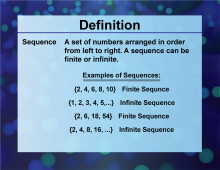
|
Definition--Sequences and Series Concepts--Sequences | SequencesTopicSequences and Series DefinitionA sequence is an ordered list of numbers that follow a particular pattern or rule. DescriptionSequences are fundamental concepts in mathematics, representing ordered lists of numbers that follow a specific pattern or rule. This concept is crucial in various mathematical applications, including algebra, calculus, and computer science. |
Sequences |
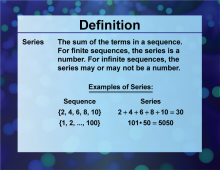
|
Definition--Sequences and Series Concepts--Series | SeriesTopicSequences and Series DefinitionA series is the sum of the terms of a sequence. DescriptionSeries are significant concepts in mathematics, representing the sum of the terms of a sequence. This concept is essential in various mathematical and scientific applications, including calculus, analysis, and financial modeling. In real-world applications, series are used in financial calculations, such as determining the total amount of payments or investments over time. They are also used in data analysis to find the sum of a dataset. Algebraically, series can be represented in various forms, such as arithmetic series, geometric series, and more. |
Series |

|
Definition--Sequences and Series Concepts--Square Numbers | Square NumbersTopicSequences and Series DefinitionSquare numbers are numbers that are the square of an integer. DescriptionSquare numbers are fundamental concepts in mathematics, representing numbers that are the square of an integer. This concept is crucial in various mathematical applications, including algebra, geometry, and number theory. In real-world applications, square numbers are used in area calculations, particularly in determining the area of squares. They are also used in computer algorithms and cryptography. Algebraically, square numbers can be represented as n2 , where n is an integer. |
Sequences |
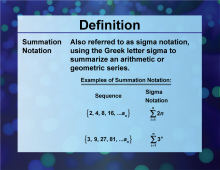
|
Definition--Sequences and Series Concepts--Summation Notation | Summation NotationTopicSequences and Series DefinitionSummation notation is a mathematical notation used to represent the sum of a sequence of terms. DescriptionSummation notation is a powerful tool in mathematics, representing the sum of a sequence of terms in a compact form. This concept is essential in various mathematical and scientific applications, including calculus, statistics, and computer science. |
Series |
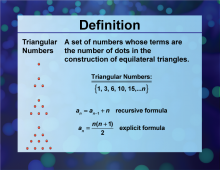
|
Definition--Sequences and Series Concepts--Triangular Numbers | Triangular NumbersTopicSequences and Series DefinitionTriangular numbers are numbers that can be represented by an equilateral triangle. DescriptionTriangular numbers are fundamental concepts in mathematics, representing numbers that can form an equilateral triangle. This concept is crucial in various mathematical applications, including algebra, geometry, and number theory. In real-world applications, triangular numbers are used in combinatorial problems and in determining the number of connections in a network. They are also used in computer algorithms and game design. Algebraically, triangular numbers can be represented as |
Sequences |

|
Definition--Statistics and Probability Concepts--Histogram | HistogramTopicStatistics and Probability DefinitionA histogram is a graphical representation of data distribution using bars of different heights. DescriptionHistograms are a fundamental tool in statistics for visualizing the frequency distribution of a dataset. They are used across various fields, including economics, biology, and engineering, to analyze data patterns and trends. By displaying data in intervals, histograms help identify the shape, central tendency, and variability of data. For students, understanding histograms is crucial for interpreting data visually and making informed decisions based on statistical evidence. |
Data Analysis |
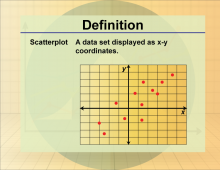
|
Definition--Statistics and Probability Concepts--Scatterplot | ScatterplotTopicStatistics and Probability DefinitionA scatterplot is a graphical representation of the relationship between two numerical variables. DescriptionScatterplots are essential tools in statistics for visualizing the correlation between two variables. They are widely used in fields like economics and biology to identify trends and relationships in data. For students, understanding scatterplots is important for interpreting data visually and analyzing the strength and direction of relationships between variables. This skill is crucial for developing their ability to conduct statistical analyses and draw meaningful conclusions from data. |
Data Analysis |
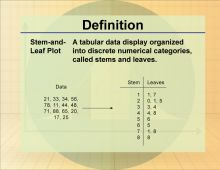
|
Definition--Statistics and Probability Concepts--Stem-and-Leaf Plot | Stem-and-Leaf PlotTopicStatistics and Probability DefinitionA stem-and-leaf plot is a graphical representation that organizes data points based on their place value. DescriptionStem-and-leaf plots are useful for displaying the distribution of a dataset in a concise format, preserving the original data while showing its shape. They are particularly helpful in exploratory data analysis to identify patterns and outliers. In educational settings, stem-and-leaf plots are used to teach students about data organization and visualization. Understanding this concept helps students develop skills in data interpretation and enhances their ability to summarize data effectively. |
Data Analysis |

|
Formulas--Median | Formulas--Median
The formula for the Median. This is part of a collection of math formulas. To see the complete collection of formulas, click on this link. Note: The download is a JPG file.Related ResourcesTo see resources related to this topic click on the Related Resources tab above. |
Data Analysis |
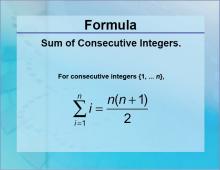
|
Formulas--Sum of Consecutive Integers | Formulas--Sum of Consecutive Integers
The formula for the Sum of Consecutive Integers. This is part of a collection of math formulas. To see the complete collection of formulas, click on this link. Note: The download is a JPG file.Related ResourcesTo see resources related to this topic click on the Related Resources tab above. |
Sequences and Series |

|
Formulas--Sum of Consecutive Odd Integers | Formulas--Sum of Consecutive Odd Integers
The formula for the Sum of Consecutive Integers. This is part of a collection of math formulas. To see the complete collection of formulas, click on this link. Note: The download is a JPG file.Related ResourcesTo see resources related to this topic click on the Related Resources tab above. |
Sequences and Series |
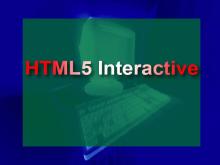
|
HTML5 Interactive: Data Displays | HTML5 Interactive: Data Displays
In this interactive, review seven commonly used data displays. Provides a quck review tool for a unit on data analysis. Note: the download is the Teacher's Guide. This is part of a collection of math games and interactives. To see the complete collection of the games, click on this link. Note: The download is the teacher's guide.Related ResourcesTo see additional resources on this topic, click on the Related Resources tab. |
Data Gathering and Data Analysis |

|
INSTRUCTIONAL RESOURCE: Algebra Application: The Rise of K-Pop | INSTRUCTIONAL RESOURCE: Algebra Application: The Rise of K-Pop
In this Algebra Application, students examine the music industry, specifically the rise of Korean pop music, or K-Pop. Using industry data students examine tables and graphs of categorical data before identifying possible functional relationships. A mathematical model is developed to explore the relationship between viral videos and sales. Topics covered: Mathematical modeling, Linear regression, Categorical data, Functions. |
Applications of Linear Functions and Data Analysis |

|
INSTRUCTIONAL RESOURCE: Algebra Application: When Will Space Travel Be Affordable? | INSTRUCTIONAL RESOURCE: Algebra Application: When Will Space Travel Be Affordable?
In this Algebra Application, students examine the budding industry of commercial space travel. Using data from the Bureau of Transportation Statistics, students build a mathematical model from historical airfare data. This model is used to predict when commercial space travel will become affordable. This also includes a discussion of inflation-adjusted costs and the future value of money. Topics covered: Mathematical modeling, Linear regression, Exponential functions, The time value of money. |
Applications of Exponential and Logarithmic Functions, Applications of Linear Functions and Data Analysis |
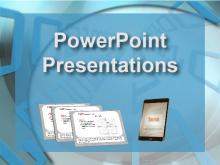
|
Instructional Resource: Applications of Linear Functions: Circumference vs. Diameter | In this Slide Show, apply concepts of linear functions to the context of circumference vs. diameter. Note: The download is a PPT file. Related ResourcesTo see the complete collection of Tutorials on this topic, click on this link: https://bit.ly/3g0P3cN |
Applications of Linear Functions |

|
Instructional Resource: Applications of Linear Functions: Cost vs. Time | In this Slide Show, apply concepts of linear functions to the context of cost vs. time data and graphs. Note: The download is a PPT file. Related ResourcesTo see the complete collection of Tutorials on this topic, click on this link: https://bit.ly/3g0P3cN |
Applications of Linear Functions |

|
Instructional Resource: Applications of Linear Functions: Cricket Chirps | In this Slide Show, apply concepts of linear functions to the context of cricket chirps. Note: The download is a PPT file. Related ResourcesTo see the complete collection of Tutorials on this topic, click on this link: https://bit.ly/3g0P3cN |
Applications of Linear Functions |

|
Instructional Resource: Applications of Linear Functions: Distance vs. Time | In this Slide Show, apply concepts of linear functions to the context of distance vs. time data and graphs. Note: The download is a PPT file. Related ResourcesTo see the complete collection of Tutorials on this topic, click on this link: https://bit.ly/3g0P3cN |
Applications of Linear Functions |

|
Instructional Resource: Applications of Linear Functions: Hooke's Law | In this Slide Show, apply concepts of linear functions to the context of Hooke's law. Note: The download is a PPT file. Related ResourcesTo see the complete collection of Tutorials on this topic, click on this link: https://bit.ly/3g0P3cN |
Applications of Linear Functions and Proportions |

|
Instructional Resource: Applications of Linear Functions: Momentum and Impulse | In this Slide Show, apply concepts of linear functions to the context of momentum and impulse. Note: The download is a PPT file. Related ResourcesTo see the complete collection of Tutorials on this topic, click on this link: https://bit.ly/3g0P3cN |
Applications of Linear Functions |

|
Instructional Resource: Applications of Linear Functions: Perimeter of a Rectangle | In this Slide Show, apply concepts of linear functions to the context of rectangular perimeter. Note: The download is a PPT file. Related ResourcesTo see the complete collection of Tutorials on this topic, click on this link: https://bit.ly/3g0P3cN |
Applications of Linear Functions |

|
Instructional Resource: Applications of Linear Functions: Saving Money | In this Slide Show, apply concepts of linear functions to the context of saving money. Note: The download is a PPT file. Related ResourcesTo see the complete collection of Tutorials on this topic, click on this link: https://bit.ly/3g0P3cN |
Applications of Linear Functions |

|
Instructional Resource: Applications of Linear Functions: Speed and acceleration | In this Slide Show, apply concepts of linear functions to the context of speed and acceleration. Note: The download is a PPT file. Related ResourcesTo see the complete collection of Tutorials on this topic, click on this link: https://bit.ly/3g0P3cN |
Applications of Linear Functions |

|
Instructional Resource: Applications of Linear Functions: Temperature Conversion | In this Slide Show, apply concepts of linear functions to the context of converting Celsius and Fahrenheit temperatures. Note: The download is a PPT file. Related ResourcesTo see the complete collection of Tutorials on this topic, click on this link: https://bit.ly/3g0P3cN |
Applications of Linear Functions |

|
INSTRUCTIONAL RESOURCE: Nspire App Tutorial: Graphing a Scatterplot | In this Slide Show, learn how graph data in a scatterplot using the graph window. This presentation requires the use of the TI-Nspire iPad App. Note: the download is a PPT. |
Graphs of Linear Functions, Slope-Intercept Form and Data Analysis |
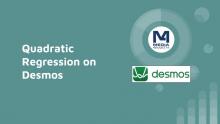
|
Instructional Resource: Quadratic Regression on Desmos | INSTRUCTIONAL RESOURCE: Tutorial: Quadratic Regression on Desmos
In this tutorial we walk students through the steps of doing a quadratic regression on a Desmos graphing calculator. The steps include showing how to create pseudo-quadratic data on a spreadsheet. This is part of a collection of tutorials on a variety of math topics. To see the complete collection of these resources, click on this link. Note: The download is a PPT file.Library of Instructional ResourcesTo see the complete library of Instructional Resources , click on this link. |
Quadratic Equations and Functions and Data Analysis |

|
Interactive Word Search Puzzle--Data Analysis, Puzzle 1 | Interactive Word Search Puzzle--Data Analysis, Puzzle 1
Solve an interactive word search puzzle on the topic of Data Analysis. This is part of a collection of math games and interactives. To see the complete collection of the games, click on this link. Note: The download is the teacher's guide.Related ResourcesTo see additional resources on this topic, click on the Related Resources tab. |
Data Analysis |
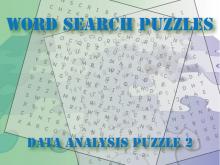
|
Interactive Word Search Puzzle--Data Analysis, Puzzle 2 | Interactive Word Search Puzzle--Data Analysis, Puzzle 2
Solve an interactive word search puzzle on the topic of Data Analysis. This is part of a collection of math games and interactives. To see the complete collection of the games, click on this link. Note: The download is the teacher's guide.Related ResourcesTo see additional resources on this topic, click on the Related Resources tab. |
Data Analysis |
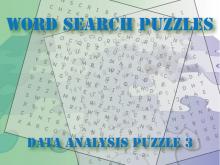
|
Interactive Word Search Puzzle--Data Analysis, Puzzle 3 | Interactive Word Search Puzzle--Data Analysis, Puzzle 3
Solve an interactive word search puzzle on the topic of Data Analysis. This is part of a collection of math games and interactives. To see the complete collection of the games, click on this link. Note: The download is the teacher's guide.Related ResourcesTo see additional resources on this topic, click on the Related Resources tab. |
Data Analysis |
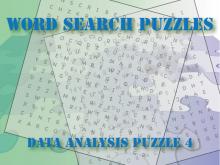
|
Interactive Word Search Puzzle--Data Analysis, Puzzle 4 | Interactive Word Search Puzzle--Data Analysis, Puzzle 4
Solve an interactive word search puzzle on the topic of Data Analysis. This is part of a collection of math games and interactives. To see the complete collection of the games, click on this link. Note: The download is the teacher's guide.Related ResourcesTo see additional resources on this topic, click on the Related Resources tab. |
Data Analysis |
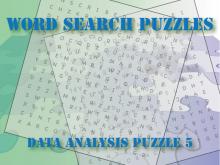
|
Interactive Word Search Puzzle--Data Analysis, Puzzle 5 | Interactive Word Search Puzzle--Data Analysis, Puzzle 5
Solve an interactive word search puzzle on the topic of Data Analysis. This is part of a collection of math games and interactives. To see the complete collection of the games, click on this link. Note: The download is the teacher's guide.Related ResourcesTo see additional resources on this topic, click on the Related Resources tab. |
Data Analysis |
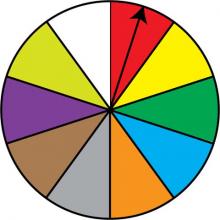
|
Math Clip Art: Spinner, 10 Sections--Result 1 | Math Clip Art: Spinner, 10 Sections--Result 1TopicProbability and Statistics DescriptionThis image depicts a spinner divided into ten equal sections, which are colored red, yellow, green, light blue, orange, grey, brown, purple, yellow-green, and white. The spinner's arrow points to the red section, demonstrating one of the possible outcomes. In the context of Probability and Statistics, this spinner represents a probability experiment with ten equally likely outcomes. It visually demonstrates the concepts of sample space and individual events within that space, each with a 1/10 probability of occurrence. |
Probability |
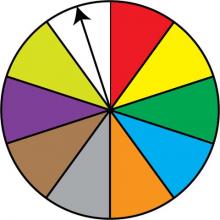
|
Math Clip Art: Spinner, 10 Sections--Result 10 | Math Clip Art: Spinner, 10 Sections--Result 10TopicProbability and Statistics DescriptionThis image depicts a spinner divided into ten equal sections, which are colored red, yellow, green, light blue, orange, grey, brown, purple, yellow-green, and white. The spinner's arrow points to the white section, demonstrating the final possible outcome in this probability model. In the field of Probability and Statistics, this spinner exemplifies a uniform probability distribution with ten equally likely outcomes. Each spin has a 1/10 probability of landing on any given color, illustrating the concept of equiprobable events in a complex scenario. |
Probability |